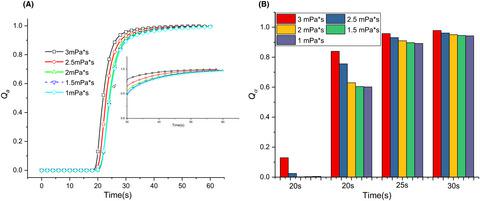当前位置:
X-MOL 学术
›
Energy Sci. Eng.
›
论文详情
Our official English website, www.x-mol.net, welcomes your
feedback! (Note: you will need to create a separate account there.)
A liquid-solid model to optimize the application of friction reducers for hydraulic fracturing/cutting in the underground coal mine
Energy Science & Engineering ( IF 3.5 ) Pub Date : 2021-06-10 , DOI: 10.1002/ese3.930 Wei Xiong 1, 2 , Kai Shen 1, 2, 3 , Quanbin Ba 1, 2 , Yanbao Liu 1, 2 , Houquan Zhou 1, 2
Energy Science & Engineering ( IF 3.5 ) Pub Date : 2021-06-10 , DOI: 10.1002/ese3.930 Wei Xiong 1, 2 , Kai Shen 1, 2, 3 , Quanbin Ba 1, 2 , Yanbao Liu 1, 2 , Houquan Zhou 1, 2
Affiliation

|
Friction reducers are widely applied to reduce friction losses in the natural oil and gas industry. The application of hydraulic fracturing in underground coal mines results in a new issue for friction reducers: The hydraulic fluid, mixed with a friction reducer, should reduce friction loss to maintain the hydraulic pressure while simultaneously discharging coal particles to clean the borehole. Most previous studies have focused on the former aspect, ignoring the discharge capacity of coal particles. To compensate for this shortcoming, a coupled flow model of coal particles and hydraulic fluid is proposed considering the interactions between the two phases and characteristics of the coal particles. The model was implemented and solved using the finite element method approach (COMSOL Multiphysics), and the impact of the injection velocity, hydraulic fluid viscosity, and stacking angle of coal particles was investigated. Before simulation, an experiment was conducted to determine the viscosity range and velocity dependency of the hydraulic fluid with a flow-loop instrument. A field application was conducted based on simulation results. The viscosity of 2.5 mPa s is a critical value around which the maximum friction reduction efficiency can be achieved, and the discharge capacity of coal particles can be enhanced significantly above this value. The applications of hydraulic fracturing or hydraulic cutting should be coupled with the viscosity of the hydraulic fluid. The injection velocity should be sufficiently high, and the time interval of the water spray should be sufficiently large for the low-viscosity hydraulic fluid. The stacking angle of the coal particles has little influence on the long-term discharge process. An upward borehole is recommended for the consideration of coal particle discharge because of the gravity effect. This work provides constructive suggestions and guidance for underground hydraulic fracturing and hydraulic cutting.
中文翻译:

一种优化减摩剂在煤矿井下水力压裂/切割中应用的液-固模型
减摩剂被广泛应用于减少天然石油和天然气行业的摩擦损失。水力压裂在煤矿井下的应用给减摩剂带来了一个新的问题:液压油与减摩剂混合后,应减少摩擦损失以维持水压,同时排出煤粒清洁井眼。以往的研究大多集中在前一个方面,而忽略了煤颗粒的放电能力。为了弥补这一缺点,考虑到煤颗粒和液压流体两相之间的相互作用和煤颗粒的特性,提出了煤颗粒和液压流体的耦合流动模型。使用有限元方法 (COMSOL Multiphysics) 实施和求解模型,以及注射速度的影响,对液压油粘度、煤粒堆积角进行了研究。在模拟之前,进行了一项实验,以确定液压流体的粘度范围和速度依赖性,并使用流量回路仪器。根据模拟结果进行了现场应用。2.5 mPa s 的粘度是一个临界值,在该值附近可以实现最大的减摩效率,高于此值可以显着提高煤颗粒的排放能力。水力压裂或水力切割的应用应与液压流体的粘度相结合。喷射速度要足够高,对于低粘度液压油,喷水的时间间隔要足够大。煤粒堆积角度对长期放电过程影响不大。由于重力效应,考虑煤粒排放,建议向上钻孔。该工作为地下水力压裂和水力切割提供了建设性的建议和指导。
更新日期:2021-06-10
中文翻译:

一种优化减摩剂在煤矿井下水力压裂/切割中应用的液-固模型
减摩剂被广泛应用于减少天然石油和天然气行业的摩擦损失。水力压裂在煤矿井下的应用给减摩剂带来了一个新的问题:液压油与减摩剂混合后,应减少摩擦损失以维持水压,同时排出煤粒清洁井眼。以往的研究大多集中在前一个方面,而忽略了煤颗粒的放电能力。为了弥补这一缺点,考虑到煤颗粒和液压流体两相之间的相互作用和煤颗粒的特性,提出了煤颗粒和液压流体的耦合流动模型。使用有限元方法 (COMSOL Multiphysics) 实施和求解模型,以及注射速度的影响,对液压油粘度、煤粒堆积角进行了研究。在模拟之前,进行了一项实验,以确定液压流体的粘度范围和速度依赖性,并使用流量回路仪器。根据模拟结果进行了现场应用。2.5 mPa s 的粘度是一个临界值,在该值附近可以实现最大的减摩效率,高于此值可以显着提高煤颗粒的排放能力。水力压裂或水力切割的应用应与液压流体的粘度相结合。喷射速度要足够高,对于低粘度液压油,喷水的时间间隔要足够大。煤粒堆积角度对长期放电过程影响不大。由于重力效应,考虑煤粒排放,建议向上钻孔。该工作为地下水力压裂和水力切割提供了建设性的建议和指导。











































 京公网安备 11010802027423号
京公网安备 11010802027423号